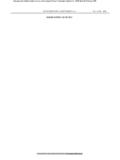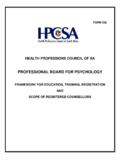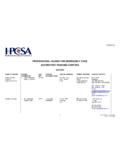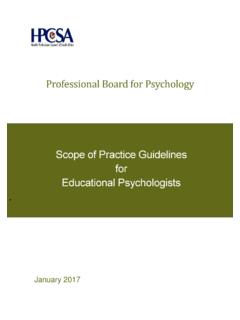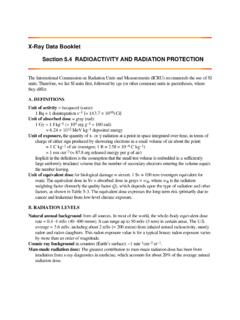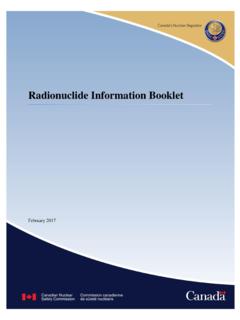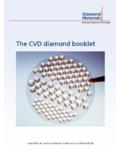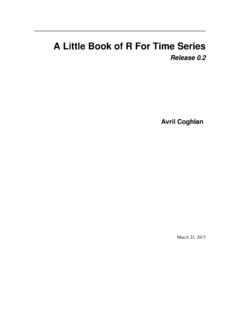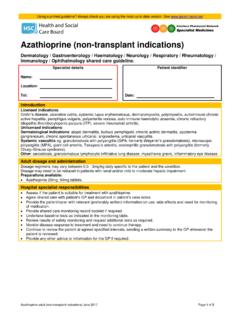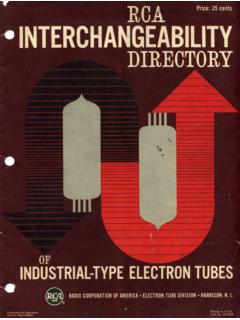Transcription of HEALTH PROFESSIONS COUNCIL OF SOUTH AFRICA
1 HEALTH PROFESSIONS COUNCIL OF SOUTH AFRICA GUIDELINES FOR GOOD PRACTICE IN THE HEALTH CARE PROFESSIONS GUIDELINES ON THE KEEPING OF PATIENT RECORDS BOOKLET 14 PRETORIA MAY 2008 ii HEALTH PROFESSIONS COUNCIL of SOUTH AFRICA Post Office Box 205 Pretoria 0001 Telephone: (012) 338 9300 Fax: (012) 328 4863 E-mail: Website: i THE SPIRIT OF PROFESSIONAL GUIDELINES Practice as a HEALTH care professional is based upon a relationship of mutual trust between patients and HEALTH care practitioners. The term profession means a dedication, promise or commitment publicly made .1 To be a good HEALTH care practitioner, requires a life-long commitment to sound professional and ethical practices and an overriding dedication to the interests of one s fellow human beings and society.
2 In essence, the practice of HEALTH care PROFESSIONS is a moral enterprise. In this spirit the HPCSA presents the following ethical guidelines to guide and direct the practice of HEALTH care practitioners. These guidelines form an integral part of the standards of professional conduct against which a complaint of professional misconduct will be evaluated. [Note: The term HEALTH care practitioner in these guidelines refers to persons registered with the HPCSA]. 1 Pellegrino, ED. Medical professionalism: Can it, should it survive? J Am Board Fam Pract 2000; 13(2):147-149 (quotation on p. 148). ii TABLE OF CONTENTS 1 DEFINITION OF A HEALTH RECORD.
3 1 2 WHAT CONSTITUTES A HEALTH RECORD? .. 1 3 WHY DOCUMENTS OR MATERIALS SHOULD BE RETAINED .. 1 4 COMPULSORY KEEPING OF RECORDS .. 2 5 SIGNING OF OFFICIAL DOCUMENTS .. 2 6 CERTIFICATES AND REPORTS .. 3 7 ISSUING OF PRESCRIPTIONS .. 3 8 ALTERATION OF RECORDS .. 4 9 DURATION FOR THE RETENTION OF HEALTH RECORDS .. 4 10 OWNERSHIP OF RECORDS .. 5 11 ACCESS TO RECORDS .. 6 12 RETENTION OF PATIENT RECORDS ON CD-ROM .. 7 13 CHECKLIST FOR HEALTH RECORD-KEEPING .. 7 GUIDELINES ON THE KEEPING OF PATIENT RECORDS These guidelines are applicable to HEALTH care practitioners in private practice (including managed HEALTH care organisations), as well as to those in the employ of the public service. 1 DEFINITION OF A HEALTH RECORD A HEALTH record may be defined as any relevant record made by a HEALTH care practitioner at the time of or subsequent to a consultation and / or examination or the application of HEALTH A HEALTH record contains the information about the HEALTH of an identifiable individual recorded by a HEALTH care professional, either personally or at his or her 2 WHAT CONSTITUTES A HEALTH RECORD?
4 The following documents can be regarded as the essential components of a HEALTH record, obviously depending on the nature of the individual case: Hand-written contemporaneous notes taken by the HEALTH care practitioner. Notes taken by previous practitioners attending HEALTH care or other HEALTH care practitioners, including a typed patient discharge summary or summaries. Referral letters to and from other HEALTH care practitioners. Laboratory reports and other laboratory evidence such as histology sections, cytology slides and printouts from automated analysers, X-ray films and reports, ECG races, etc. Audiovisual records such as photographs, videos and tape-recordings. Clinical research forms and clinical trial data.
5 Other forms completed during the HEALTH interaction such as insurance forms, disability assessments and documentation of injury on duty. Death certificates and autopsy reports. The above records may be archived on microfilm, microfiche or magnetic data files. 3 WHY DOCUMENTS OR MATERIALS SHOULD BE RETAINED Documents and materials should be retained in order to: Further the diagnosis or ongoing clinical management of the patient; Conduct clinical audits; Promote teaching and research; 2 de Klerk A. The right of patients to have access to their medical records: the position in SOUTH African law. Medical Law, Vol 12, 1993, pp. 77 - 83 3 Making and keeping medical records.
6 MPS Casebook 13 (International), July 2000, 6-8 Be used for administrative or other purposes; Be kept as direct evidence in litigation or for occupational disease or injury compensation purposes; Be used as research data; Be kept for historical purposes; Promote good clinical and laboratory practices; Make case reviews possible; Serve as the basis for 4 COMPULSORY KEEPING OF RECORDS HEALTH care practitioners should enter and maintain at least the following information for each patient consulted: Personal (identifying) particulars of the patient. The bio-psychosocial history of the patient, including allergies and idiosyncrasies. The time, date and place of every consultation.
7 The assessment of the patient s condition. The proposed clinical management of the patient. The medication and dosage prescribed. Details of referrals to specialists, if any. The patient s reaction to treatment or medication, including adverse effects. Test results. Imaging investigation results. Information on the times that the patient was booked off from work and the relevant reasons. Written proof of informed consent, where applicable. Records should be kept in non-erasable ink and erasure fluid should not be used. 5 SIGNING OF OFFICIAL DOCUMENTS Rule 15 of the HPCSA s ethical rules states that: Any student, intern or practitioner who, in the execution of his or her professional duties, signs official documents relating to patient care, such as prescriptions, certificates(excluding death certificates) patient records, hospital or other reports, shall do so by signing such document next to his or her initials and surname in block letters.
8 4 Royal College of Pathologists, Marks and Spencer Publications Unit. The retention and storage of pathological records and Archives, London, Royal College of Pathologists, 1995 6 CERTIFICATES AND REPORTS According to Rule 16 of the ethical guidelines: (1) A practitioner shall only grant a certificate of illness if such certificate contains the following information, namely - (a) the name, address and qualification of the practitioner; (b) the name of the patient; (c) the employment number of the patient (if applicable); (d) the date and time of the examination; (e) whether the certificate is being issued as a result of personal observations by the practitioner during an examination, or as the result of information received from the patient and which is based on acceptable medical grounds; (f) a description of the illness, disorder or malady in layman's terminology with the informed consent of the patient: Provided that if the patient is not prepared to give such consent, the medical practitioner or dentist shall merely specify that, in his or her opinion based on an examination of the patient, the patient is unfit to work.
9 (g) whether the patient is totally indisposed for duty or whether the patient is able to perform less strenuous duties in the work situation; (h) the exact period of recommended sick leave; (i) the date of issuing the certificate of illness; and (j) a clear indication of the identity of the practitioner who issued the certificate which shall be personally and originally signed by him or her next to his or her initials and surname in printed or block letters. (2) If preprinted stationery is used, a practitioner shall delete words which are irrelevant. (3) A practitioner shall issue a brief factual report to a patient where such a patient, requires information concerning himself or herself. 7 ISSUING OF PRESCRIPTIONS On the issuing of prescriptions, Rule 17 states that: A practitioner - (a) shall be permitted to issue typewritten, computer-generated, pre-typed, pre-printed or standardised prescriptions for medicine scheduled in schedules I, II, III and IV of the Medicines and Related Substances Control Act, 1965 (Act No.)
10 101 of 1965), subject thereto that such prescriptions may only be issued under his or her personal and original signature; (b) shall issue handwritten prescriptions for medicine scheduled in schedules 5,6,7 and 8 above of the Act referred to in paragraph (a) under his or her personal and original signature (see also rule 14). 8 ALTERATION OF RECORDS No information or entry may be removed from a HEALTH record. An error or incorrect entry discovered in the record may be corrected by placing a line through it with ink and correcting it. The date of change must be entered and the correction must be signed in full. The original record must remain intact and fully legible.

